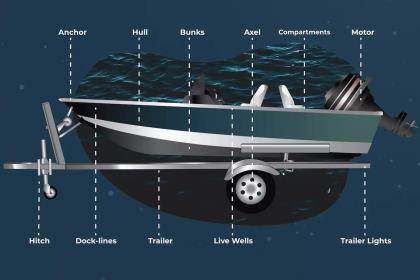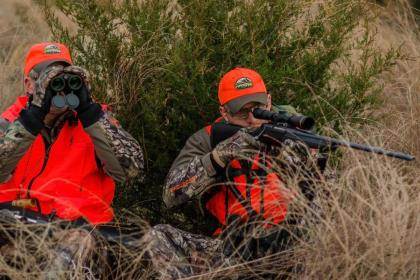The management of wolves, bears, lions and even coyotes forms the front lines of the hottest conservation skirmishes in America.
https://www.gameandfishmag.com/editorial/how-large-predators-could-impact-hunting-of-all-game/500409

June 27, 2024By Andrew McKean
In Colorado this fall, voters could decide to outlaw hunting for mountain lions and bobcats. That’s on the heels of a controversial reintroduction of wolves—mandated by another Colorado ballot initiative—last December. In Washington two years ago, an activist fish and wildlife commission’s first act was indefinitely closing a popular spring black bear hunt. Meanwhile in New Jersey, black bear hunting has been stop and go for decades as governors flip-flop on their stances regarding bear management (sometimes for the better) and anti-hunting groups pressure lawmakers into hunting bans.
On the other side of the yawning abyss that separates predator advocates from predator critics, Idaho’s legislature passed a bill in 2021 that allows hunters and trappers to kill up to 90 percent of the state’s wolf population. Over in Montana, trappers are allowed to use neck snares and baits to take wolves, and until a judge blocked the practice last summer, hunters were able to use thermal and night-vision optics to target wolves on private land.
Want to get an anti-hunter all riled up? Tell him how much you like hunting coyotes. You’ll get a similarly aggressive response from a hard-core hunter when you tell him that killing coyotes doesn’t have a meaningful effect on deer and elk populations. Welcome to the most polarizing topic in wildlife conservation in America: the management of predators.
FOLLOW THE SCIENCE
Very few other subjects elicit such an emotional response as our relationship with bears, wolves, lions and other wild felines and canines. Many anti-hunting groups raise millions of dollars on campaigns to end predator hunting, forgetting that management, in the form of legal, scientifically based hunting, is a humane tool to keep predators in balance with prey populations. Some of our most rabid pro-hunting groups also agitate around predators, behaving as though the only good wolf (or lion or bear) is a dead one, similarly forgetting that predator populations are vital for keeping ungulate populations healthy and balanced.
Advertisement
×https://www.gameandfishmag.com/video_iframev9.aspx?vid=0&pronly=true&sz=400×300&ad-tag-video-id=285353&playloc=1&playerLocation=inline-one&playerType=default&reset=1719603056
Lost in the noise about either the nobility or savagery of predators is our responsibility as hunter-conservationists to respect, pay attention to and scientifically manage all wildlife. Just as anti-hunters rally around individual animals with cute names and Instagram accounts, we are prone to focus on populations with horns, antlers and tasty backstraps.
The polarizing role of predators was recognized by the father of wildlife management, Aldo Leopold, who wrote in 1949 that “Harmony with the land is like harmony with a friend; you cannot cherish his right hand and chop off his left. That is to say, you cannot have game and hate predators.”
The purpose of this column isn’t to change anyone’s mind about the function of predators in our various ecosystems. Instead, it’s designed to highlight the outsized part that predators are playing in wider discussions about the role of hunting and to point out how predators are politicizing what should be apolitical natural-resource discussions.
Advertisement
×https://www.gameandfishmag.com/video_iframev9.aspx?vid=0&pronly=true&sz=400×300&ad-tag-video-id=285353&playloc=2&playerLocation=inline-two&playerType=default&reset=1719603067
BALLOT-BOX BIOLOGY
The schism between the two sides of the predator war is on full display in Colorado, where voters in 2020 approved Proposition 114, which required the state’s wildlife agency to reintroduce gray wolves. Last December, 10 wolves captured in eastern Oregon were released on Colorado’s Western Slope, to the delight of animal-rights groups and to the dismay of many pro-hunting groups.
This fall, Colorado voters will likely decide the fate of Ballot Initiative 91 that proposes to ban the hunting and trapping of mountain lions and bobcats in the state. If passed, the initiative would impose Class 1 misdemeanor penalties on violators of the law and revoke their hunting privileges. The law is expressly intended “to ban trophy hunting of mountain lions, bobcats, and lynx [lynx are already protected by law] in Colorado,” according to the initiative’s language, because it “is inhumane, serves no socially acceptable or ecologically beneficial purpose, and fails to further public safety.”
Anti-hunting groups are going after wild felines in part because of a perception that hunters don’t consume the meat of lions, despite the requirement from Colorado Parks and Wildlife to do so, and are instead interested only in the hides, claws and skulls of “trophy” animals. This is a popular misperception, one that anti-hunters have exploited to turn voters against hunting, since most non-hunters say they support hunting as long as licensed hunters consume the meat of legally harvested animals. Although the initiative specifies “trophy hunting,” it defines that term as “intentionally killing, wounding, pursuing, or entrapping a mountain lion, bobcat, or lynx,” which is essentially an outright ban on all forms of regulated hunting and trapping.
The situation in Colorado illustrates a couple of disturbing trends. First is that anti-hunters are likely to use ballot initiatives to stop or curtail predator hunting in other states. Compared with widely known deer, elk, small-game and turkey hunters, predator hunters are few in number and have specialized gear and hunting traditions, which makes anti-hunting ballot measures surprisingly effective in rapidly urbanizing Western states. Second, the proposed lion-hunting ban has gained traction because hunting wild felines with dogs is perceived by non-hunters to be cruel and unusual. And because lion hunters make extensive use of specialized technologies like GPS-connected dog-tracking collars, anti-hunters claim the activity violates fair-chase ethics.
All these attributes of a mountain lion hunt could apply to black bear hunts, wolf hunts and even coyote hunts in some areas. If we want to stop this sort of “ballot-box biology” from affecting other hunts in other states, we need to be aware of the political vulnerabilities of some of our predator-hunting methods. Dedicated groups like Coloradans for Responsible Wildlife Management (savethehuntcolorado.com) provide education to the public and representation among lawmakers to battle against anti-hunting measures like Initiative 91.
Recommended

Weighing the Benefits—and Drawbacks—of Non-Lead Fishing TackleRead Article

New Tools, Survey Help in ‘Clean.Drain.Dry’ Fight Against Aquatic Invasive SpeciesRead Article

Perspective: A PR Problem for Field SportsRead Article

Sportsmen’s Group Aims to Protect Our Outdoors HeritageRead Article
Advertisement
UNDER-REGULATED?
It’s worth looking at how the other side of predator management might impact the regulation of hunting. When it comes to hunting and trapping predators, could there be too much of a good thing?
Since 1995, when wolves were introduced by the U.S. Fish and Wildlife Service to Yellowstone National Park, the wild canines have been considered unwelcome interlopers across wide swaths of the West. As the species has grown in population and distribution—the gray wolf has been on and off the Endangered Species List but finally removed from federal protection in 2017—management authority has rightly been given to state agencies. Idaho and Montana both allow liberal harvest and hunting and trapping methods, but it turns out there’s a cost to all that opportunity.
The U.S. Fish and Wildlife Service has cited Western states’ “inadequate regulatory mechanism” of wolves as evidence that the predator should be returned to federal protections, even though the population and distribution of wolves have far exceeded delisting benchmarks. If wolves are returned to endangered species status because of states’ overreach, Western hunters will lose hard-won hunting opportunities. Furthermore, the relisting of wolves would undoubtedly delay the long-awaited delisting of grizzly bears.
We must pay careful attention to both sides of the predator divide while remembering our responsibility to conservation hinges on scientific management. Anti-hunters see a chance at victory in Colorado. They’ve already succeeded elsewhere, and the strange politics of fang and claw may determine our opportunities to hunt other species in the future.
